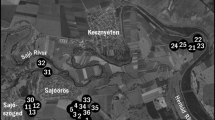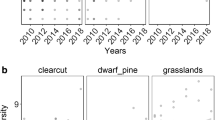Abstract
Understanding how to restore threatened ecosystems is of special relevance for nature conservation. The aim of this study was to use Orthoptera as ecological indicators for the effects of montane heathland restoration in Central Europe. We analysed the three following treatments: (i) montane heathlands (MONHEATH) (N = 7), (ii) restoration sites (RESSITE) (N = 3) and (iii) clear-cuts of spruce forests as unprocessed and ungrazed control sites (CONTROL) (N = 3). Vegetation structure and microclimate differed considerably between MONHEATH on the one hand and RESSITE and CONTROL on the other hand. Orthoptera species richness and density did so too. MONHEATH was characterised by a high-growing dense dwarf-shrub and moss layer having a cool microclimate and high soil moisture. In contrast, RESSITE and CONTROL had sparse vegetation and a warm microclimate; Orthoptera species richness and density was highest on these sites. Our study clearly showed that heathland Orthoptera responded rapidly to restoration measures, while Ericaceae dwarf shrubs slowly established. The vast majority of Orthoptera species found on the restoration sites are early and mid-successional species. The colonization of the sites by late-successional Orthoptera species in the future will depend on the further development of the heathland vegetation; that is, if Ericaceae will expand to the sites. We conclude that the realised restoration measures are suitable to promote heathland Orthoptera of early and mid-successional stages. However, the current management of montane heathlands is insufficient and needs to be intensified in order to provide structurally diverse habitats with their characteristic orthopteran assemblages.




Similar content being viewed by others
References
Bazelet CS, Samways MJ (2011) Identifying grasshopper bioindicators for habitat quality assessment of ecological networks. Ecol Indica 11:1259–1269
Behrens M, Fartmann T (2004) Die Heuschreckengemeinschaften isolierter Schieferkuppen der Medebacher Bucht (Südwestfalen/Nordhessen). Tuexenia 24:303–327
Bellmann H (2006) Der Kosmos Heuschreckenführer. Die Arten Mitteleuropas sicher bestimmen. Kosmos, Stuttgart
Belovsky GE, Slade JB (1993) The role of vertebrate and invertebrate predators in a grasshopper community. Oikos 68:193–201
Berdowski JJM (1993) The effect of external stress and disturbance factors on Calluna-dominated heathland vegetation. In: Aerts R, Heil GW (eds) Heathlands: Patterns and processes in a changing environment. Kluwer Academic Publishers, Dordrecht, pp 85–124
Bobbink R, Hornung M, Roelofs GM (1998) The effects of air-borne nitrogen pollutants on species diversity in natural and semi-natural European vegetation: a review. J Ecol 86:717–738
Breder C, Schubert W (1998) Hochheide-Management am Beispiel des Naturschutzgebietes “Neuer Hagen” (Hochsauerlandkreis). Jahrbuch Naturschutz in Hessen 3:208–215
Britton AJ, Pearce ISK, Jones B (2005) Impacts of grazing on montane heath vegetation in Wales and implications for the restoration of montane areas. Biol Conserv 125:515–524
Bullock JM, Pakeman RJ (1996) Grazing of lowland heath in England: management methods and their effects on heathland vegetation. Biol Conserv 79:1–13
Chappell MA, Whitman DW (1990) Grasshopper thermoregulation. In: Chapman RF, Joern A (eds) Biology of grasshoppers. Wiley, New York, pp 143–172
Coray A, Lehmann AW (1998) Taxonomie der Heuschrecken Deutschlands (Orthoptera): Formale Aspekte der wissenschaftlichen Namen. Articulata Beiheft 7:63–152
Diaz A, Green I, Tibett M (2008) Re-creation of heathland on improved pasture using top soil removal and sulphur amendments: Edaphic drivers and impacts on ericoid mycorrhizas. Biol Conserv 141:1628–1635
Fartmann T, Mattes M (1997) Heuschreckenfauna und Grünland–Bewirtschaftungsmaßnahmen und Biotopmanagement. Arb Inst Landschaftsökol 3:179–188
Fartmann T, Behrens M, Lortiz H (2008) Orthopteran communities in the conifer-broadleaved woodland zone of the Russian Far East. Eur J Entomol 105:673–680
Fartmann T, Krämer B, Stelzner F, Poniatowski D (2012) Orthoptera as ecological indicators for succession in steppe grassland. Ecol Indica 20:337–344
Felton M, Marsden L (1990) Heather regeneration in England and Wales: a feasibility study for the Department of the Environment by the Nature Conservancy Council. Nature Conservancy Council, Petersborough
Fielding AH, Haworth PF (1995) Testing the generality of bird-habitat models. Conserv Biol 9:1466–1481
Gardiner T, Dover J (2008) Is microclimate important for Orthoptera in open landscapes? J Insect Conserv 12:705–709
Gardiner T, Hill J (2006) A comparison of three sampling techniques used to estimate population density and assemblage diversity of Orthoptera. J Orthop Res 15:45–51
Gardiner T, Pye M, Field R, Hill J (2002) The influence of sward height and vegetation composition in determining the habitat preferences of three Chorthippus species (Orthoptera: Acrididae) in Chelmsford, Essex, UK. J Orthop Res 11:207–213
Gardiner T, Hill J, Chesmore D (2005) Review of the methods frequently used to estimate the abundance of Orthoptera in grassland ecosystems. J Insect Conserv 9:151–173
Geringhoff HJT, Daniёls FJA (2003) Zur Syntaxonomie des Vaccinio-Callunetum Büker 1942 unter besonderer Berücksichtigung der Bestände im Rothaargebirge. Abhandl Westf Museum Naturk 65:1–80
Gimmingham GH (1992) The lowland heathland management handbook. English Nature Science 8, Peterborough
Haaland S (2003) Feuer und Flamme für die Heide: 5000 Jahre Kulturlandschaft in Europa. Hauschild, Bremen
Hahn V (2007) Neubegründung von Bergheideflächen auf dem Kahlen Asten. Natur in NRW 2:42–44
Hoffmann A (1998) “Hochheide”–eine Heide mit eigenen Gesetzmäßigkeiten. Jb Natursch Hessen 3:216–218
Ingrisch S, Köhler G (1998) Die Heuschrecken Mitteleuropas. Westarp Wissenschaften, Magdeburg
Keienburg T, Prüter J (2004) Conservation and management of Central European lowland heathlands. Case study: Lüneburger Heide nature reserve, North-West Germany. Mit Alfred Toepfer Akademie Natursch 15:1–64
Kiehl K, Wagner C (2006) Effect of hay transfer on long-term establishment of vegetation and grasshoppers on former arable fields. Restor Ecol 14:157–166
Legge H (2009a) Zur Brutverbreitung der Heidelerche Lullula arborea im Hochsauerlandkreis. Charadrius 45:213–218
Legge H (2009b) Brutbestandserfassung von Baum-Anthus trivialis und Wiesenpieper Anthus pratensis im NSG “Neuer Hagen”im Jahr 2007. Charadrius 45:219–224
Leyer I, Wesche K (2007) Multivariate Statistik in der Ökologie. Springer, Berlin
Lindemann K-O (1993) Die Rolle von Deschampsia flexuosa in Calluna-Heiden Mitteleuropas. NNA Berichte 5:20–39
Marshall JA, Haes ECM (1988) Grasshoppers and allied insects of Great Britain and Ireland. Harley Books, Colchester
Matesanz S, Valladares F, Tena D, Costa-Tenorio M, Bote D (2006) Early dynamics of plant communities on revegetated motorway slopes from southern Spain: is hydroseeding always needed? Restor Ecol 14:297–307
Michael N (1993) The lowland heathland management booklet. English Nature Science 11, Peterborough
Montoro J, Alvarez Rogel J, Querejeta J, Diaz E, Castello V (2000) Three hydro-seeding revegetation techniques for soil erosion control on anthropic steep slopes. Land Degrad Dev 11:315–325
MUNLV, Ministerium für Umwelt und Naturschutz, Landwirtschaft und Verbraucherschutz (2012) Natura 2000 Gebiete in Nordrhein-Westfalen. http://www.naturschutzinformationen-nrw.de/natura2000-meldedok/de/karten. Accessed 7 Aug 2012
Poniatowski D, Fartmann T (2007) Kleinräumig heterogen strukturierte Hochheiden in mikroklimatisch günstiger Lage: Lebensräume der Kurzflügeligen Beißschrecke (Metrioptera brachyptera) im Quellgebiet der Diemel (Südwestfalen/Nordhessen). Articulata 22:153–171
Poniatowski D, Fartmann T (2008) The classification of insect communities: lessons from orthopteran assemblages of semi-dry calcareous grasslands in central Germany. Eur J Entomol 105:659–671
Poniatowski D, Fartmann T (2011a) Weather-driven changes in population density determine wing dimorphism in a bush-cricket species. Agric Ecosyst Environ 145:5–9
Poniatowski D, Fartmann T (2011b) Dispersal capability in a habitat specialist bush cricket: the role of population density and habitat moisture. Ecol Entomol 36:717–723
Pywell RF, Meek WR, Webb NR, Putwain PD, Bullock JM (2011) Long-term heathland restoration on former grassland: the results of a 17-year experiment. Biol Conserv 144:1602–1609
Ratcliffe DA, Thompson DBA (1988) The British uplands: their ecological character and international significance. In: Usher MB, Thompson DBA (eds) Ecological change in the Uplands. Blackwell, Oxford, pp 9–36
Sala OE, Chapin FS, Armesto JJ, Berlow E, Bloomfield J, Dirzo R, Huber-Sanwald E, Huenneke LF, Jackson RB, Kinzig A, Leemans R, Lodge DM, Mooney HA, Oesterheld M, Poff NL, Sykes MT, Walker BH, Walker M, Wall DH (2000) Biodiversity—global biodiversity scenarios for the year 2100. Science 287:1770–1774
Schirmel J, Blindow I, Fartmann T (2010) The importance of habitat mosaics for Orthoptera (Caelifera and Ensifera) in dry heathlands. Eur J Entomol 107:129–132
Schirmel J, Mantilla-Contreras J, Blindow I, Fartmann T (2011) Impacts of succession and grass encroachment on Orthoptera in heathlands. J Insect Conserv 15:633–642
Schlumprecht H, Waeber G (2003) Heuschrecken in Bayern. Eugen Ulmer, Stuttgart
Ssymank A, Hauke U, Rückriem C, Schröder E (1998) Das europäische Schutzgebietssystem NATURA 2000. BfN-Handbuch zur Umsetzung der Fauna-Flora-Habitat-Richtlinie und der Vogelschutz-Richtlinie. Schriftenr Landschaftspfl Natursch 53:1–560
Stoutjesdijk P, Barkman JJ (1992) Microclimate vegetation and fauna. Opulus, Uppsala
Sundseth K (2005) Natura 2000 in the Atlantic region. European Commission Environment, Brussels
Symes N, Day J (2003) A practical guide to the restoration and management of lowland heathland. RSPB, Sandy
Thompson DBA, MacDonald AJ (1995) Upland heather moorland in Great Britain: a Review of international importance, vegetation change and some objectives for nature conservation. Biol Conserv 71:163–178
Usher MB (1992) Management and diversity of arthropods in Calluna heathland. Biodivers Conserv 1:63–79
Usher MB, Thompson DBA (1993) Variation in the upland heathlands of Great Britain: conservation importance. Biol Conserv 66:69–81
Walker KJ, Pywell RF, Warman EA, Fowbert JA, Bhogal A, Chambers BJ (2004) The importance of former land use in determining successful re-creation of lowland heath in southern England. Biol Conserv 116:289–303
Walker KJ, Warman EA, Bhogal A, Cross BC, Pywell RF, Meek BR, Chambers BJ, Pakeman R (2007) Recreation of lowland heathland on ex-arable land: assessing the limiting processes on two sites with contrasting spoil fertility and pH. J Appl Ecol 44:573–582
Wessel WW, Tietema A, Beier C, Emmett BA, Penuelas J, Riis-Nielsen T (2004) A qualitative ecosystem assessment for different shrublands in Western Europe under impact of climate change. Ecosystems 7:662–671
Willott SJ, Hassall M (1998) Life-history responses of British grasshoppers (Orthoptera: Acrididae) to temperature change. Funct Ecol 12:232–241
Wünsch Y, Schirmel J, Fartmann T (2012) Conservation management of coastal dunes for Orthoptera has to consider oviposition and nymphal preferences. J Insect Conserv 16:501–510
Acknowledgments
The study was funded by the Deutsche Bundesstiftung Umwelt (DBU) as part of the research project “restoration of montane heathland ecosystems in Central Europe”. The heathland restoration was co-financed by the LIFE project “Medebacher Bucht”.
Author information
Authors and Affiliations
Corresponding author
Rights and permissions
About this article
Cite this article
Borchard, F., Schulte, A.M. & Fartmann, T. Rapid response of Orthoptera to restoration of montane heathland. Biodivers Conserv 22, 687–700 (2013). https://doi.org/10.1007/s10531-013-0438-z
Received:
Accepted:
Published:
Issue Date:
DOI: https://doi.org/10.1007/s10531-013-0438-z




